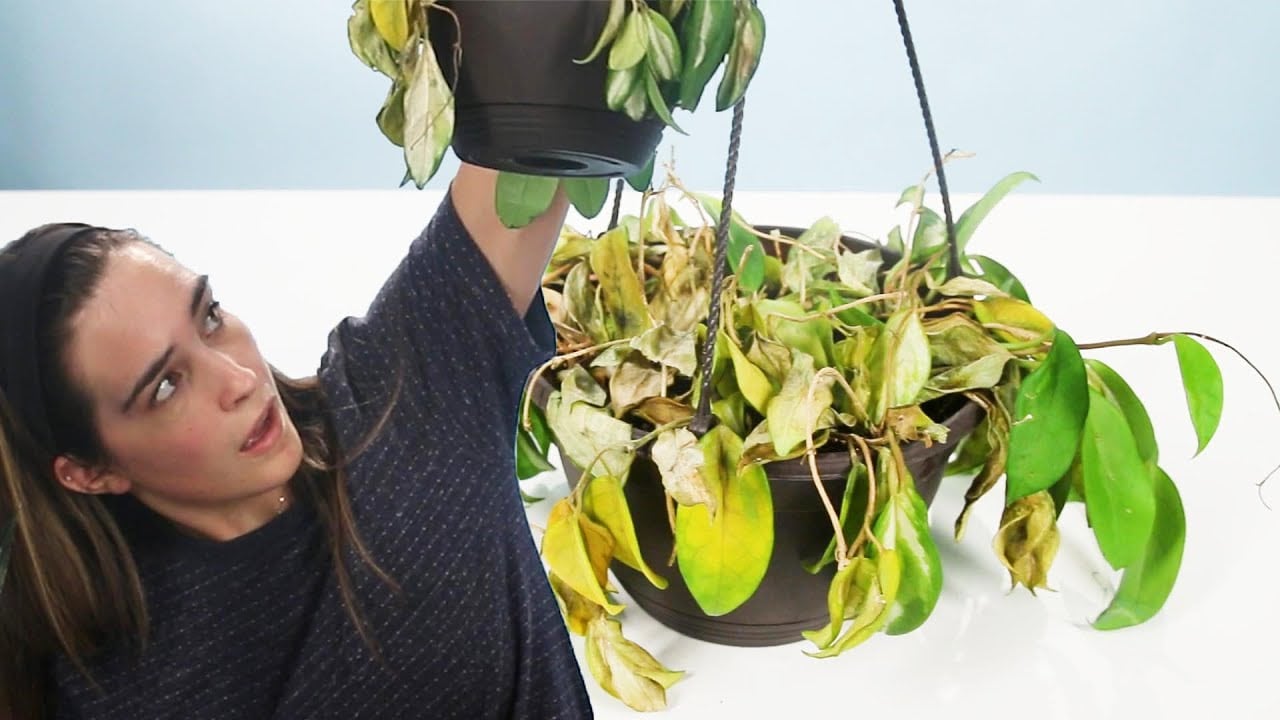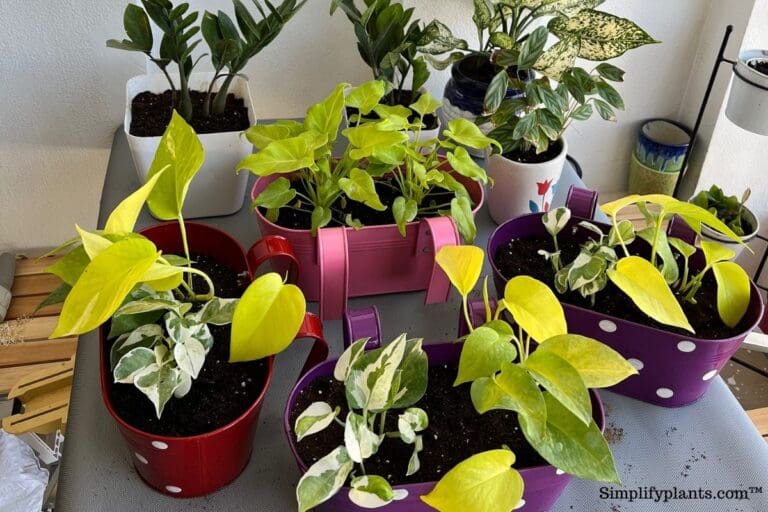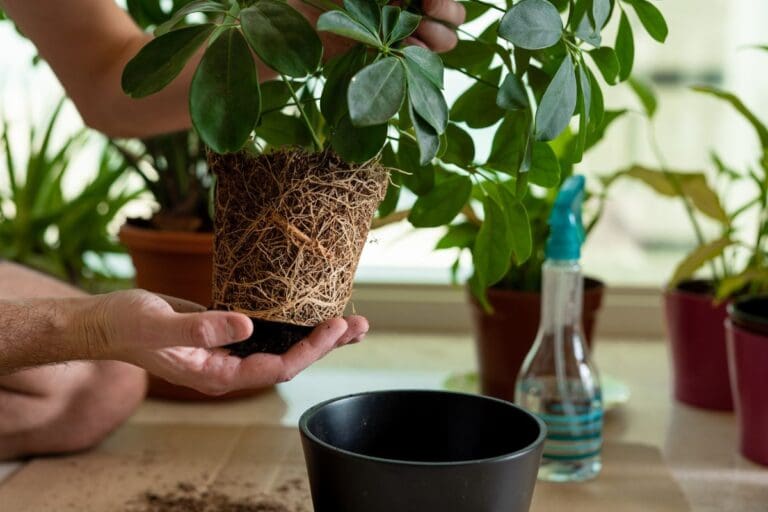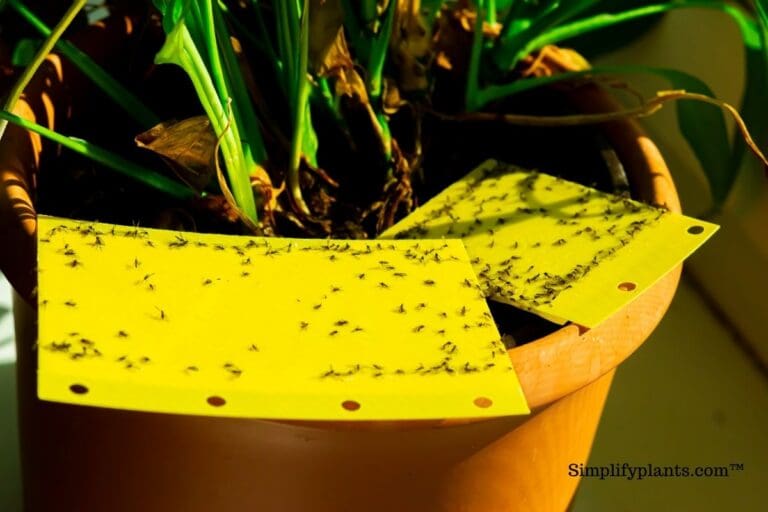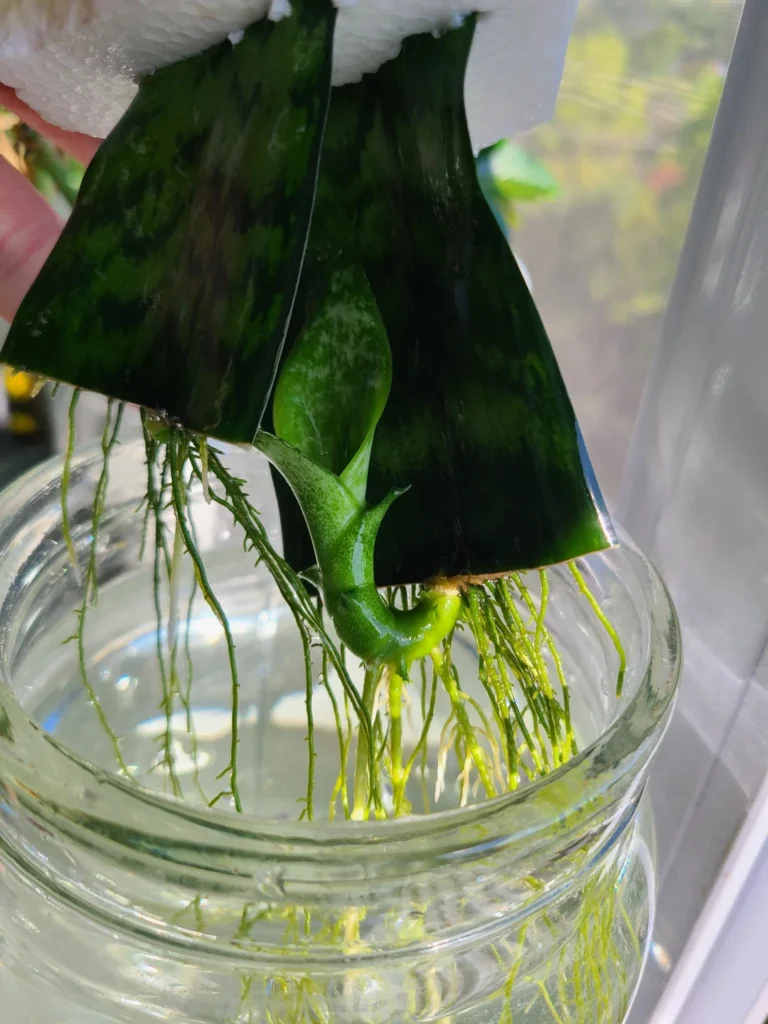Why Is My Indoor Plant Dying? (Causes+Solution)
Indoor plants make the best home decor, along with providing us oxygen and fresh air. But seeing your indoor plants die might be stressing you out, especially if you cannot figure out the reason.
So, in this article, we will discuss all the possible problems due to which your indoor plant might be dying.
Indoor plants die when their primary care requirements are not met. Low lighting conditions, improper watering, wrong soil mix, and pest infestation are significant problems that lead to a wilting plant. Provide indirect light, well-drained soil, and water adequately to save your plant from dying.
If you don’t understand the basic requirements of your indoor plants, you might be making a mistake that is killing the plant. So the first thing you need to determine is what is going wrong.
A plant that is not doing well or is about to die will show you different signs such as yellow leaves, brown leaves, foul odor coming from the soil, and so on.
This article will dive into all the reasons that might be causing your indoor plants to die and some care tips that will help keep your plants healthy.

Please note: Simplify Plants is reader-supported. Some links in the post are affiliate links and I get a commission from purchases made through links in the post.
Signs your indoor plant is dying
Your indoor plants will not die suddenly but will give out different signs at different stages of the problems. We have listed out some common signs that you will notice when your indoor plant is dying.
- Yellow leaves
- Brown leaves
- Spots on leaves
- Holes in leaves
- Droopy leaves
- Leaves falling off
- Dull foliage
- Roots coming out of the pot
- Foul smell coming from the soil
- Plant leaning to one side
You might notice various other unusual signs on your plants, but more important is finding out the reasons behind these signs. Keep an eye on your plant to avoid getting too late for you to save the plant.
Why are my indoor plants dying?
We will take a quick look at all the reasons that might be leading to the death of your houseplant.
- Improper watering
- Poor drainage system
- Wrong water temperature
- Poor water quality
- Wrong watering pattern
- Lack of light
- Too much light
- Pest infestation
- Fungal infections
- Overfertilization
- Underfertilization
- Lack of humidity
- Wrong pot size
- Transplant shock
- Wrong research
We will discuss these in detail, so it is easier for you to understand what is going wrong with your plant.
Improper watering
Different indoor plants come with different water requirements. But as a general rule, no houseplant prefers to be overwatered or kept thirsty for too long.
If you are not watering your houseplant correctly, you will end up overwatering or underwatering it, both of which can kill your plant.
Overwatering
Overwatering is a common problem as people myth that giving more water will make the plant healthier.
However, their myth bursts when the plant develops yellow leaves, brown leaves, smelly soil, etc. All these are caused due to overwatering.
Overwatering makes the soil saturated with water, blocking the oxygen flow. The roots get suffocated and fail to perform their regular functions, such as delivering water and nutrients to the plant.
Due to staying wet for too long, the roots start to rot. This condition is called root rot, where the roots become moist and brown. Repotting the plant after getting rid of the damaged roots is the only way of treating root rot.
If you catch the early signs of overwatering, you can save the plant before the roots start rotting. But if it is already too late, you might not be able to save your dying indoor plant.
Underwatering

Just like other living beings, plants, too, need water for survival. If you don’t water your houseplants when they need it, the health of the plants will undoubtedly deteriorate.
Most houseplants appreciate slightly moist soil, and for that, you need to water the plants the food the soil gets completely dry. Underwatering will make the soil go hard, due to which the roots will not be able to absorb any nutrients, leading to a weak plant.
Few signs of an underwatered plant are droopy leaves, dry and crisp foliage, and a dull-looking plant. A prolonged period of underwatering can kill your indoor plant.
To avoid stressing your plant and killing it out of underwatering, maintain a calendar and water the plant before the soil dries up completely.
Also read: Overwatering Vs Underwatering Plants: Signs, Fix & More
Poor drainage system
Having a sound drainage system is extremely important for a healthy indoor plant. You might be watering your houseplant correctly, but it can get overwatered if the drainage system doesn’t work well.
When talking about the drainage system, we point to a pot with drainage holes and a well-draining soil mix.
If the pot you are using for your houseplant does not have drainage holes, the water will not have any way of getting out of the pot. Therefore, the extra water will remain in the pot, making the soil soggy and leading to overwatering.
On the other hand, if the soil fails to drain water quickly and retains moisture for an extended period, the soil will not dry up on time, which will suffocate the roots and cause overwatering.
Therefore, if you don’t want your plant to die because of a poor drainage system, consider getting a pot with drainage holes and adding material such as sand or perlite to the soil, which will improve the drainage.
Wrong water temperature

Most indoor plants prefer room temperature, and the same logic applies to the water. You cannot use water that is is too hot or too cold as it can shock your plant.
You must always use room temperature water to water your indoor plants. If the water temperature is not ideal, you can cool it down or heat it to match the room temperature and then use it on your plants.
Plants that get shocked by the wrong water temperature might get severely damaged, and you might not be able to recover the damages.
Poor water quality
Other than the correct temperature, using good quality water is a must. If you wonder what good quality water means, it means water that does not contain harmful minerals.
The tap water that we usually use contains minerals like chlorine, fluorine which are harmful to the plants. Using such water will lead to an unhealthy plant, and you will see signs like spots on leaves.
You can get the tap water checked to find out if it contains those harmful minerals. If yes, switch to filtered water. You can collect rainwater and use it on your plants.
If you don’t have these options, leave the tap water under the open air for a few hours and let the minerals evaporate. You can then use this water on your indoor plants.
Wrong watering pattern
Enthusiasts make a lot of mistakes when it comes to watering their indoor plants. We have already mentioned the common mistakes, but there might be even more.
If you are watering the foliage every time you water the houseplants, you are making a mistake. If the leaves remain wet most of the time, they will attract pests a develop fungal infections. If you don’t identify the issue on time, this can lead to the death of your houseplant.
The best way to water your indoor plant is by following the bottom watering method. You water only the soil without making the leaves wet.
Another mistake you are making is not watering thoroughly. Most houseplants require deep watering, which means the water should reach the innermost roots.
You are doing it wrong if the water doesn’t drain out of the drainage holes after you water your plants.
The best way is to slightly water the soil and let the soil soak the water. After 2-3 minutes, what are the soil thoroughly until the excess water starts coming out of the drainage holes.
Lack of light

Without sufficient light, you will not notice proper growth in your indoor plants. Many indoor plants can survive in low light, but they require sufficient light to grow and sustain themselves.
If you have placed your houseplant in a dark corner of the house, you will notice that your plant might be leaning towards one side in search of light, or the stems might be growing long and spindly with very few leaves on them.
If you keep neglecting these signs, it means you are leaving your plants to die. But if you want to improve the conditions, move your indoor plant to a brighter area where it will get sufficient indirect light.
If you cannot provide enough sunlight, you can get artificial lights and place those on top of your plants. This will help your plant recover and become healthy again.
Too much light
You should provide everything in moderation to your indoor plants. Similar to low light, excess light or direct sunlight can be the reason behind a sick houseplant.
First of all, most indoor plants cannot tolerate direct sunlight, with a few exceptions like cacti and succulents. If you expose your indoor plants to direct sunlight or too much light, you will notice signs like brown and crisp upper leaves and dried-up soil.
Direct sunlight can scorch the leaves of your indoor plants in a few hours, and these damages are irreversible.
If this is the issue with your houseplant, you need to prune the damaged leaves and find a spot where the plant will stay protected from direct sunlight.
If your house plant is placed on the balcony or patio, try to find a shaded spot for it. Or, use curtains or blinds to filter the direct sunlight coming from the windows.
Also read: Can Indoor Plants Get Too Much Light?
Pest infestation

Pests don’t usually attack healthy houseplants, but they attack plants that are overwatered for weak due to some previous conditions. Pests are tiny bugs that feed on your plants, making them weak and unhealthy.
Pests are hard to get rid of as they populate very fast and are hard to spot because of their tiny size. If you don’t identify the signs on time, the pests will take over your plant and kill it before you know it.
Some common pests that attack indoor plants are aphids, mealybugs, spider mites, scales, whiteflies, fungus gnats, etc. You might come across signs like holes on the leaves, a weak plant, white spots on leaves, etc.
To eliminate the pests, first, isolate the affected plant from the other houseplants. Next, you need to remove the damaged areas and apply alcohol to the affected areas. You can also spray a Neem Oil solution on the plant for at least two weeks to kill these pests.
You can prevent pest infestation by keeping your plant healthy and not overwatering it. You can also spray a Neem oil solution once a month to keep the pests at bay.
Fungal infections
Fungal infections are deadly as they spread very fast. Fungal infections are hard to get rid of, so you must always keep your indoor plants healthy so that there are no chances of fungal infections.
Common fungal infections found on indoor plants are powdery mildew, mold, Botrytis, stem and root rot, etc. An overwatered plant is most prone to fungal infections.
You will notice spots on leaves and stems, and the leaves might even fall off. You can use commercial fungicides to get rid of fungal infections.
But if you want to use something organic, you can mix 2 tbsp of vinegar with 1-quart water and spray on the infected areas. Continue this for a few days until the infections are gone.
Overfertilization
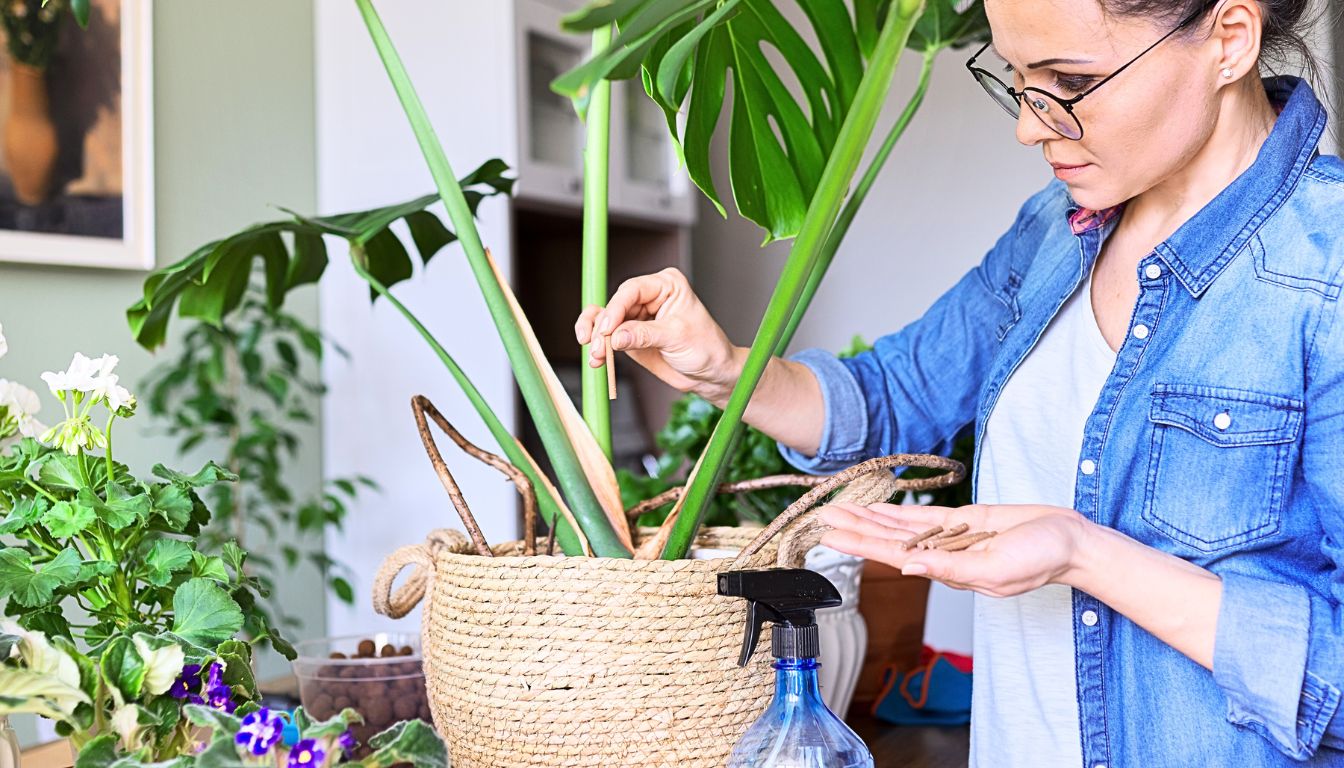
Fertilization keeps the plant healthy and strong, but overfertilization does the opposite. When you give too much fertilizer to your houseplants, the extra fertilizer gets stored in the soil.
The extra fertilizer changes the pH of the soil and burns the roots and leaves of the plant. Some common signs of overfertilization are yellowing of lower leaves, brown tips on leaves, stunted growth, etc.
If you notice these, it’s time to check the amount of fertilizer you give to your plants. If you ignore the signs, you oK will end up losing your plant.
If you already have an overfertilized houseplant:
- You must stop fertilizing immediately.
- Remove the damaged portions.
- Let the plant recover.
- Fertilize only after the plant has recovered completely and is showing new growth.
You must always use a balanced fertilizer on your indoor plants. Using a diluted dose is the best way of avoiding overfertilization.
Underfertilization
Although under fertilization is rarely the reason behind a dying plant, not fertilizing for a prolonged period can bring problems.
The potting mix of your houseplant loses nutrients every time you water it. Therefore, without proper fertilization, the houseplant will lack sufficient nutrients.
If you want your indoor plants to remain healthy and strong, you must fertilize them, especially during the growing season. Not fertilizing can make the plants so weak that they almost die.
Different indoor plants have different fertilization requirements, so you must fertilize each plant as per its needs. However, most houseplants will not require fertilizers during winter as that is the dormant period where the plants rest.
Low humidity
If you want to see your indoor plant grow aggressively, you must take care of the humidity. Low humidity is open the reason behind slow growth, yellow and dried-out leaves.
Most houseplants come from tropical regions where they are exposed to a lot of humidity. This humidity boosts their growth and keeps the plants healthy. Without sufficient humidity, the plant is unable to grow well and soon falls victim to other problems.
Therefore, maintaining the correct humidity levels is something that you cannot miss. You must keep up your indoor plants away from heating vents and ACs. Do not expose the plant to drafts and install a humidifier to increase the humidity levels.
You can also use other methods to increase the humidity, such as using a pebble tray, grouping moisture-loving plants, and misting.
Wrong pot size

If the roots are coming out of the drainage holes, you are using the wrong sized pot, or the plant has overgrown the pot. This doesn’t indicate that your plant is dying, but this condition is called rootbound.
Keeping your plant rootbound for longer than usual can lead to a dying houseplant.
A rootbound indoor plant will start displacing the soil, and the roots will start forming a bundle. The plant will grow too heavy for the pot and might even fall over.
Some indoor plants like to remain slightly rootbound, but you must repot all indoor plants whenever they start showing signs of being rootbound. This is the only way to save your plant from further problems.
You must choose one bigger pot, loosen up the roots, and repot the plant using a fresh soil mix.
Also read: What Happens If You Put A Plant in A Pot Too Big?
Transplant shock
Your indoor plant might be experiencing a transplant shock if you have repotted it recently, and it has started showing signs of problems after that.
Transplantation is a significant change for the plants, and you must be very careful while executing this as any damage can shock the plant. If your indoor plant is going through a transplant shock, it might lose leaves or die abruptly.
The only way to save the plant is to propagate the healthy branches and be careful while repotting. You must not repot during the colder months as the plant might get shocked due to the low temperatures.
Wrong research
We often overlook this, but the internet is filled with articles that don’t state the correct information all the time. If you are trusting the wrong source and taking care of your indoor plant based on that, you can make many mistakes.
So, never trust one single source and do your research right so that you can take the proper care of your houseplant and prevent it from dying due to improper care.
Indoor plant care tips

Here are some essential care tips that you should always keep in mind to take the best care of your indoor plants.
- Water your indoor plant whenever the topsoil feels dry. Do not let the soil go bone dry, and avoid watering if the soil is still wet.
- Always use room-temperature filtered water on your houseplants.
- Keep your indoor plant near a window covered with a curtain to filter out the direct sunlight.
- Use grow lights if you are unable to provide enough natural light.
- Fertilize during the growing season with a diluted dose of a well-balanced fertilizer to avoid overfertilization.
- Avoid fertilizing during winter as the plant doesn’t need fertilizer when it rests.
- Spray a neem oil solution on the plant every month to prevent pest attacks.
- Maintain the correct humidity indoors with the help of a humidifier or by misting.
- Repot the plant once every 2-3 years but even before that if the plant starts getting rootbound.
- Avoid repotting during the cold months as the low temperatures can shock your plant.
- Clean the leaves of the plant at regular intervals to make sure that they can photosynthesize well and stay healthy.
- Place the plant in a spot that has good airflow.
Recommended Garden Supplies
| Product Image | Our Recommended Gardening Supplies | Check Offers! |
|---|---|---|
Top Top
Top
Top
Top
Top
Top
Top
Top | rePotme Houseplant and Tropical Classic Potting Soil Mix | Check Offer On Amazon |
 Top
Top
Top
Top
Top
Top
Top
Top | Espoma Organic Indoor Plant Food | Check Offer On Amazon |
 Top
Top
Top
Top
Top
Top
Top
Top | GooingTop LED Grow Light 6000K Full Spectrum Clip Plant Growing Lamp | Check Offer On Amazon |
 Top
Top
Top
Top
Top
Top
Top
Top | Soil Moisture Meter | Check Offer On Amazon |
 Top
Top
Top
Top
Top
Top
Top
Top | Govee Hygrometer Thermometer, Bluetooth Enabled! | Check Offer On Amazon |
 Top
Top | LEVOIT Humidifiers for Large Room(Best For Plants) | Check Offer On Amazon |
 Top
Top
Top
Top
Top
Top
Top
Top | Upgraded DIY Automatic Drip Irrigation Kit, 15 Potted Houseplants Support | Check Offer On Amazon |
 Top
Top
Top
Top
Top
Top
Top
Top | Stainless Steel Heavy Duty Gardening Tool Set | Check Offer On Amazon |
 Top
Top
Top
Top
Top
Top
Top
Top | Bonide Insecticidal Soap | Check Offer On Amazon |
 Top
Top
Top
Top
Top
Top
Top
Top | Bonide 32 oz Spray Neem Oil for Organic Gardening | Check Offer On Amazon |
 Top
Top
Top
Top
Top
Top
Top
Top | Garden Safe Fungicide | Check Offer On Amazon |

